Cohen I.M., Kundu P.K. Fluid Mechanics
Подождите немного. Документ загружается.

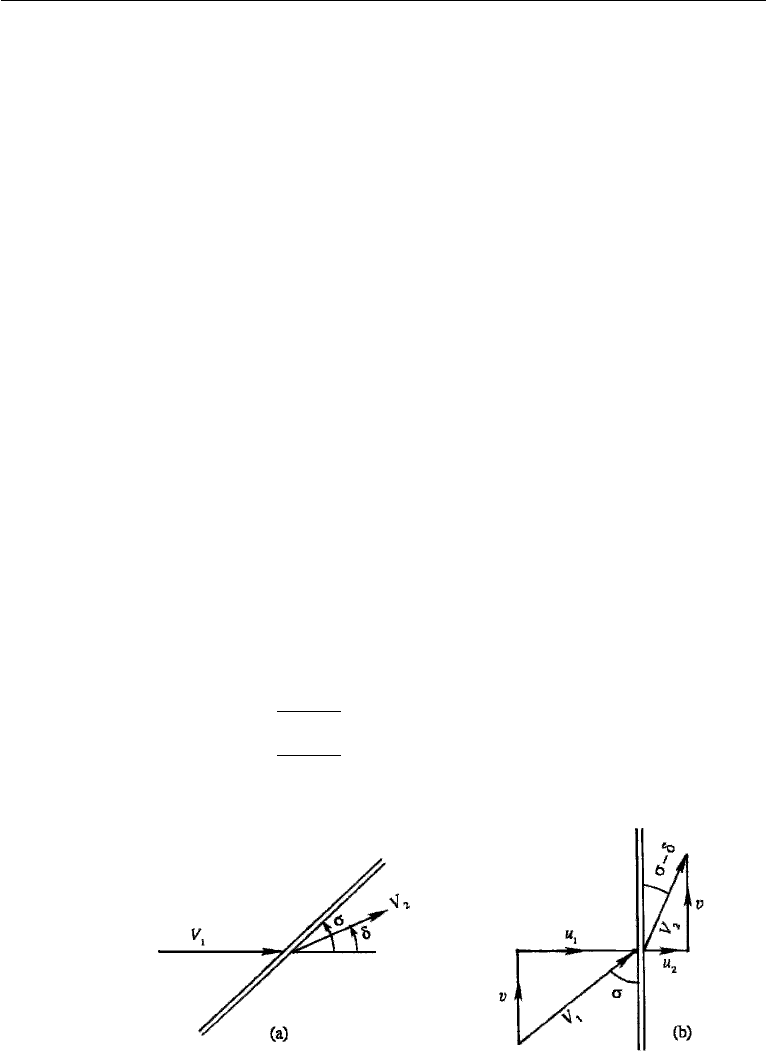
752 Compressible Flow
The Mach cone becomes wider as M decreases and becomes a plane front (that is,
µ = 90
◦
) when M = 1.
The point source considered here could be part of a solid body, which sends out
pressure waves as it moves through the fluid. Moreover, Figure 16.18c applies equally
if the point source is stationary and the fluid is approaching at a supersonic speed U .
It is clear that in a supersonic flow an observer outside the Mach cone would not
“hear” a signal emitted by a point disturbance, hence this region is called the zone
of silence. In contrast, the region inside the Mach cone is called the zone of action,
within which the effects of the disturbance are felt. This explains why the sound of a
supersonic airplane does not reach an observer until the Mach cone arrives, after the
plane has passed overhead.
At every point in a planar supersonic flow there are two Mach lines, oriented at
±µ to the local direction of flow. Information propagates along these lines, which
are the characteristics of the governing differential equation. It can be shown that the
nature of the governing differential equation is hyperbolic in a supersonic flow and
elliptic in a subsonic flow.
10. Oblique Shock Wave
In Section 6 we examined the case of a normal shock wave, oriented perpendicular to
the direction of flow, in which the velocity changes from supersonic to subsonic values.
However, a shock wave can also be oriented obliquely to the flow (Figure 16.19a),
the velocity changing from V
1
to V
2
. The flow can be analyzed by considering a
normal shock across which the normal velocity varies from u
1
to u
2
and superposing
a velocity v parallel to it (Figure 16.19b). By considering conservation of momentum
in a direction tangential to the shock, we may show that v is unchanged across a shock
(Exercise 12). The magnitude and direction of the velocities on the two sides of the
shock are
V
1
=
u
2
1
+ v
2
oriented at σ = tan
−1
(u
1
/v),
V
2
=
u
2
+ v
2
oriented at σ − δ = tan
−1
(u
2
/v).
Figure 16.19 (a) Oblique shock wave in which δ = deflection angle and σ = shock angle; and
(b) analysis by considering a normal shock and superposing a velocity v parallel to the shock.

10. Oblique Shock Wave 753
The normal Mach numbers are
M
n1
= u
1
/c
1
= M
1
sin σ>1,
M
n2
= u
2
/c
2
= M
2
sin(σ − δ) < 1.
Because u
2
<u
1
, there is a sudden change of direction of flow across the shock; in
fact the flow turns toward the shock by an amount δ. The angle σ is called the shock
angle or wave angle and δ is called the deflection angle.
Superposition of the tangential velocity v does not affect the static properties,
which are therefore the same as those for a normal shock. The expressions for the ratios
p
2
/p
1
, ρ
2
/ρ
1
, T
2
/T
1
, and (S
2
−S
1
)/C
v
are therefore those given by equations (16.31),
(16.33)–(16.35), if M
1
is replaced by the normal component of the upstream Mach
number M
1
sin σ . For example,
p
2
p
1
= 1 +
2γ
γ + 1
(M
2
1
sin
2
σ − 1), (16.39)
ρ
2
ρ
1
=
(γ + 1)M
2
1
sin
2
σ
(γ − 1)M
2
1
sin
2
σ + 2
=
u
1
u
2
=
tan σ
tan (σ − δ)
. (16.40)
The normal shock table, Table 16.2, is therefore also applicable to oblique shock
wavesifweuseM
1
sin σ in place of M
1
.
The relation between the upstream and downstream Mach numbers can be found
from equation (16.32) by replacing M
1
by M
1
sin σ and M
2
by M
2
sin (σ − δ). This
gives
M
2
2
sin
2
(σ − δ) =
(γ − 1)M
2
1
sin
2
σ + 2
2γM
2
1
sin
2
σ + 1 −γ
. (16.41)
An important relation is that between the deflection angle δ and the shock angle σ
for a given M
1
, given in equation (16.40). Using the trigonometric identity for tan (σ −
δ), this becomes
tan δ = 2 cot σ
M
2
1
sin
2
σ − 1
M
2
1
(γ + cos 2σ)+ 2
. (16.42)
A plot of this relation is given in Figure 16.20. The curves represent δ vs σ for constant
M
1
. The value of M
2
varies along the curves, and the locus of points corresponding
to M
2
= 1 is indicated. It is apparent that there is a maximum deflection angle δ
max
for oblique shock solutions to be possible; for example, δ
max
= 23
◦
for M
1
= 2.
ForagivenM
1
, δ becomes zero at σ = π/2 corresponding to a normal shock, and
at σ = µ = sin
−1
(1/M
1
) corresponding to the Mach angle. For a fixed M
1
and
δ<δ
max
, there are two possible solutions: a weak shock corresponding to a smaller
σ , and a strong shock corresponding to a larger σ . It is clear that the flow downstream
of a strong shock is always subsonic; in contrast, the flow downstream of a weak
shock is generally supersonic, except in a small range in which δ is slightly smaller
than δ
max
.
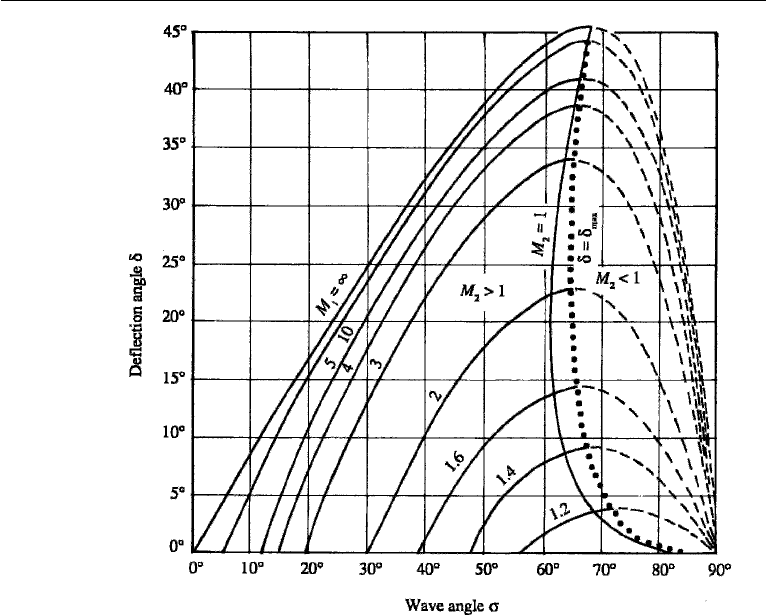
754 Compressible Flow
Figure 16.20 Plot of oblique shock solution. The strong shock branch is indicated by dashed lines, and
the heavy dotted line indicates the maximum deflection angle δ
max
. (From NACA Report 1135.)
Generation of Oblique Shock Waves
Consider the supersonic flow past a wedge of half-angle δ, or the flow over a wall
that turns inward by an angle δ (Figure 16.21). If M
1
and δ are given, then σ can be
obtained from Figure 16.20, and M
n2
(and therefore M
2
= M
n2
/sin(σ − δ)) can be
obtained from the shock table, Table 16.2. An attached shock wave, corresponding
to the weak solution, forms at the nose of the wedge, such that the flow is parallel
to the wedge after turning through an angle δ. The shock angle σ decreases to the
Mach angle µ
1
= sin
−1
(1/M
1
) as the deflection δ tends to zero. It is interesting that
the corner velocity in a supersonic flow is finite. In contrast, the corner velocity in
a subsonic (or incompressible) flow is either zero or infinite, depending on whether
the wall shape is concave or convex. Moreover, the streamlines in Figure 16.21 are
straight, and computation of the field is easy. By contrast, the streamlines in a subsonic
flow are curved, and the computation of the flow field is not easy. The basic reason
for this is that, in a supersonic flow, the disturbances do not propagate upstream of
Mach lines or shock waves emanating from the disturbances, hence the flow field can
be constructed step by step, proceeding downstream. In contrast, the disturbances
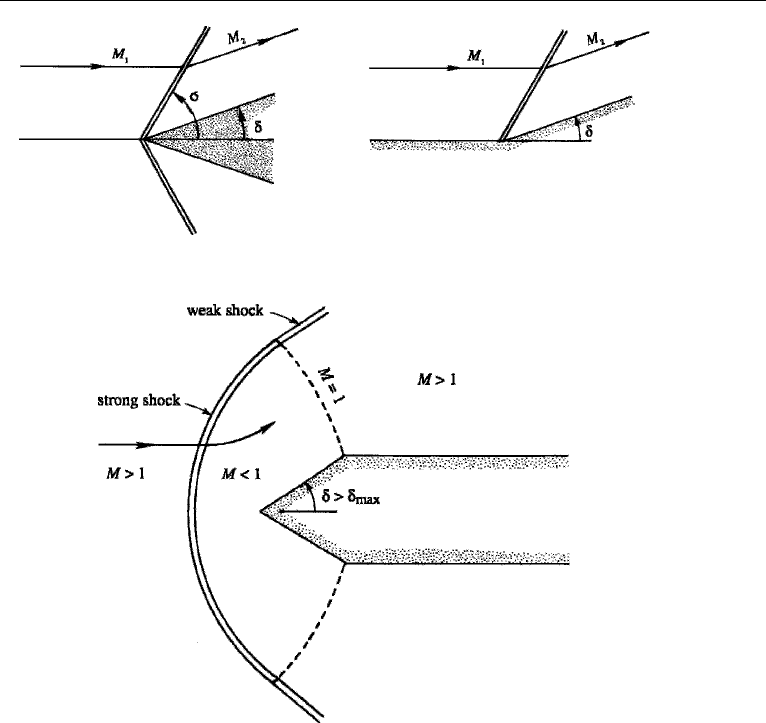
10. Oblique Shock Wave 755
Figure 16.21 Oblique shocks in supersonic flow.
Figure 16.22 Detached shock.
propagate both upstream and downstream in a subsonic flow, so that all features in
the entire flow field are related to each other.
As δ is increased beyond δ
max
, attached oblique shocks are not possible, and
a detached curved shock stands in front of the body (Figure 16.22). The central
streamline goes through a normal shock and generates a subsonic flow in front of the
wedge. The strong shock solution of Figure 16.20 therefore holds near the nose of the
body. Farther out, the shock angle decreases, and the weak shock solution applies.
If the wedge angle is not too large, then the curved detached shock in Figure 16.22
becomes an oblique attached shock as the Mach number is increased. In the case
of a blunt-nosed body, however, the shock at the leading edge is always detached,
although it moves closer to the body as the Mach number is increased.
We see that shock waves may exist in supersonic flows and their location and
orientation adjust to satisfy boundary conditions. In external flows, such as those just

756 Compressible Flow
described, the boundary condition is that streamlines at a solid surface must be tangent
to that surface. In duct flows the boundary condition locating the shock is usually the
downstream pressure.
The Weak Shock Limit
A simple and useful expression can be derived for the pressure change across a weak
shock by considering the limiting case of a small deflection angle δ. We first need to
simplify equation (16.42) by noting that as δ → 0, the shock angle σ tends to the
Mach angle µ
1
= sin
−1
(1/M
1
).
Also from equation (16.39) we note that (p
2
−p
1
)/p
1
→ 0asM
2
1
sin
2
σ −1 → 0,
(as σ → µ and δ → 0). Then from equations (16.39) and (16.42)
tan δ = 2 cot σ
γ + 1
2γ
p
2
− p
1
p
1
1
M
2
1
(γ + 1 − 2 sin
2
σ)+ 2
. (16.43)
As δ → 0, tan δ ≈ δ, cot µ =
M
2
1
− 1, sin σ ≈ 1/M
1
, and
p
2
− p
1
p
1
γM
2
1
M
2
1
− 1
δ.
(16.44)
The interesting point is that relation (16.44) is also applicable to a weak expansion
wave and not just a weak compression wave. By this we mean that the pressure
increase due to a small deflection of the wall toward the flow is the same as the
pressure decrease due to a small deflection of the wall away from the flow. This is
because the entropy change across a shock goes to zero much faster than the rate at
which the pressure difference across the wave decreases as our study of normal shock
waves has shown. Very weak “shock waves” are therefore approximately isentropic
or reversible. Relationships for a weak shock wave can therefore be applied to a weak
expansion wave, except for some sign changes. In Section 12, equation (16.44) will
be applied in estimating the lift and drag of a thin airfoil in supersonic flow.
11. Expansion and Compression in Supersonic Flow
Consider the supersonic flow over a gradually curved wall (Figure 16.23). The
wavefronts are now Mach lines, inclined at an angle of µ = sin
−1
(1/M) to the local
direction of flow. The flow orientation and Mach number are constant on each Mach
line. In the case of compression, the Mach number decreases along the flow, so that
the Mach angle increases. The Mach lines therefore coalesce and form an oblique
shock. In the case of gradual expansion, the Mach number increases along the flow
and the Mach lines diverge.
If the wall has a sharp deflection away from the approaching stream, then the
pattern of Figure 16.23b takes the form of Figure 16.24. The flow expands through
a “fan” of Mach lines centered at the corner, called the Prandtl–Meyer expansion
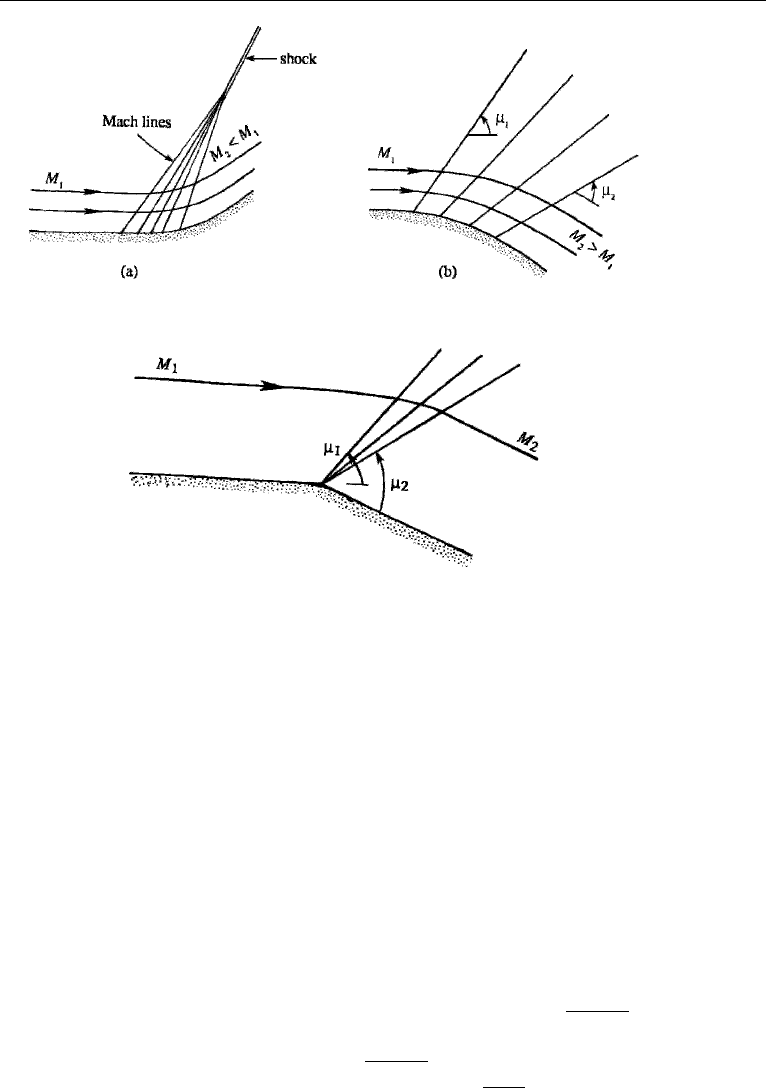
11. Expansion and Compression in Supersonic Flow 757
Figure 16.23 Gradual compression and expansion in supersonic flow: (a) gradual compression, resulting
in shock formation; and (b) gradual expansion.
Figure 16.24 The Prandtl–Meyer expansion fan.
fan. The Mach number increases through the fan, with M
2
>M
1
. The first Mach line
is inclined at an angle of µ
1
to the local flow direction, while the last Mach line is
inclined at an angle of µ
2
to the local flow direction. The pressure falls gradually along
a streamline through the fan. (Along the wall, however, the pressure remains constant
along the upstream wall, falls discontinuously at the corner, and then remains constant
along the downstream wall.) Figure 16.24 should be compared with Figure 16.21, in
which the wall turns inward and generates a shock wave. By contrast, the expansion
in Figure 16.24 is gradual and isentropic.
The flow through a Prandtl–Meyer fan is calculated as follows. From
Figure 16.19b, conservation of momentum tangential to the shock shows that the
tangential velocity is unchanged, or
V
1
cos σ = V
2
cos(σ − δ) = V
2
(cos σ cos δ + sin σ sin δ).
We are concerned here with very small deflections, δ → 0soσ → µ. Here, cos δ ≈ 1,
sin δ ≈ δ, V
1
≈ V
2
(1 + δ tan σ), so (V
2
− V
1
)/V
1
≈ δ tan σ ≈−δ/
√
M
2
1
− 1.
Regarding this as appropriate for infinitesimal change in V for an infinitesimal
deflection, we can write this as dδ =−dV
√
M
2
− 1/V (first quadrant deflection).
Because V = Mc, dV/V = dM/M + dc/c. With c =
√
γRT for a perfect gas,

758 Compressible Flow
dc/c = dT/2T . Using equation (16.20) for adiabatic flow of a perfect gas, dT/T
=−(γ − 1)M dM/[1 + ((γ − 1)/2)M
2
].
Then
dδ =−
√
M
2
− 1
M
dM
1 + ((γ − 1)/2)M
2
.
Integrating δ from 0 (radians) and M from 1 gives
δ + ν(M) = const.,
where
ν(M) =
M
1
√
M
2
− 1
1 + ((γ − 1)/2)M
2
dM
M
=
γ + 1
γ − 1
tan
−1
γ − 1
γ + 1
(M
2
− 1) − tan
−1
M
2
− 1, (16.45)
is called the Prandtl–Meyer function. The sign of
√
M
2
− 1 originates
from the identification of tan σ = tan µ = 1/
√
M
2
− 1 for a first quadrant
deflection (upper half-plane). For a fourth quadrant deflection (lower half-plane),
tan µ =−1/
√
M
2
− 1. For example, in Figure 16.23 we would write
δ
1
+ ν
1
(M
1
) = δ
2
+ ν
2
(M
2
),
where, for example, δ
1
,δ
2
, and M
1
are given. Then
ν
2
(M
2
) = δ
1
− δ
2
+ ν
1
(M
1
).
In panel (a), δ
1
− δ
2
< 0, so ν
2
<ν
1
and M
2
<M
1
. In panel (b), δ
1
− δ
2
> 0, so
ν
2
>ν
1
and M
2
>M
1
.
12. Thin Airfoil Theory in Supersonic Flow
Simple expressions can be derived for the lift and drag coefficients of an airfoil in
supersonic flow if the thickness and angle of attack are small. The disturbances caused
by a thin airfoil are small, and the total flow can be built up by superposition of small
disturbances emanating from points on the body. Such a linearized theory of lift and
drag was developed by Ackeret. Because all flow inclinations are small, we can use
the relation (16.44) to calculate the pressure changes due to a change in flow direction.
We can write this relation as
p − p
∞
p
∞
=
γM
2
∞
δ
M
2
∞
− 1
, (16.46)
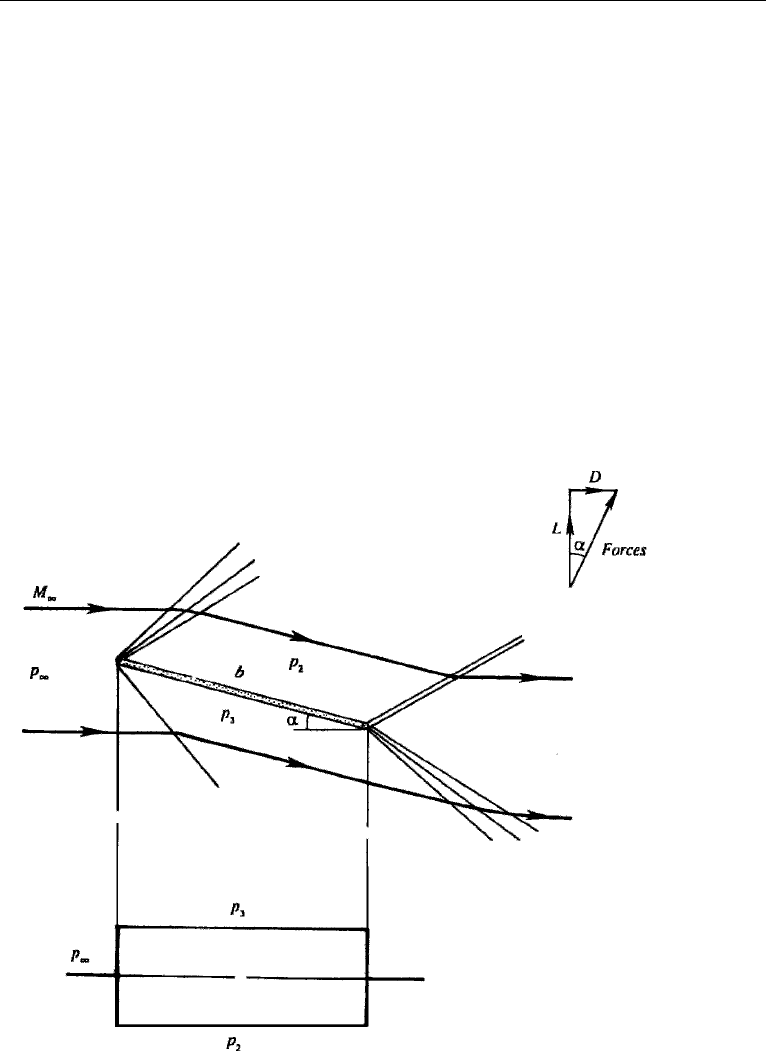
12. Thin Airfoil Theory in Supersonic Flow 759
where p
∞
and M
∞
refer to the properties of the free stream, and p is the pressure at
a point where the flow is inclined at an angle δ to the free-stream direction. The sign
of δ determines the sign of (p − p
∞
).
To see how the lift and drag of a thin body in a supersonic stream can be estimated,
consider a flat plate inclined at a small angle α to a stream (Figure 16.25). At the
leading edge there is a weak expansion fan on the top surface and a weak oblique
shock on the bottom surface. The streamlines ahead of these waves are straight. The
streamlines above the plate turn through an angle α by expanding through a centered
fan, downstream of which they become parallel to the plate with a pressure p
2
<p
∞
.
The upper streamlines then turn sharply across a shock emanating from the trailing
edge, becoming parallel to the free stream once again. Opposite features occur for
the streamlines below the plate. The flow first undergoes compression across a shock
coming from the leading edge, which results in a pressure p
3
>p
∞
. It is, however,
not important to distinguish between shocks and expansion waves in Figure 16.25,
because the linearized theory treats them the same way, except for the sign of the
pressure changes they produce.
Figure 16.25 Inclined flat plate in a supersonic stream. The upper panel shows the flow pattern and the
lower panel shows the pressure distribution.

760 Compressible Flow
The pressures above and below the plate can be found from equation (16.46),
giving
p
2
− p
∞
p
∞
=−
γM
2
∞
α
M
2
∞
− 1
,
p
3
− p
∞
p
∞
=
γM
2
∞
α
M
2
∞
− 1
.
The pressure difference across the plate is therefore
p
3
− p
2
p
∞
=
2αγ M
2
∞
M
2
∞
− 1
.
If b is the chord length, then the lift and drag forces per unit span are
L = (p
3
− p
2
)b cos α
2αγ M
2
∞
p
∞
b
M
2
∞
− 1
,
D = (p
3
− p
2
)b sin α
2α
2
γM
2
∞
p
∞
b
M
2
∞
− 1
.
(16.47)
The lift coefficient is defined as
C
L
≡
L
(1/2)ρ
∞
U
2
∞
b
=
L
(1/2)γp
∞
M
2
∞
b
,
where we have used the relation ρU
2
= γpM
2
. Using equation (16.47), the lift and
drag coefficients for a flat lifting surface are
C
L
4α
M
2
∞
− 1
,
C
D
4α
2
M
2
∞
− 1
.
(16.48)
These expressions do not hold at transonic speeds M
∞
→ 1, when the process of
linearization used here breaks down. The expression for the lift coefficient should be
compared to the incompressible expression C
L
2πα derived in the preceding chap-
ter. Note that the flow in Figure 16.25 does have a circulation because the velocities
at the upper and lower surfaces are parallel but have different magnitudes. However,
in a supersonic flow it is not necessary to invoke the Kutta condition (discussed in
the preceding chapter) to determine the magnitude of the circulation. The flow in
Figure 16.25 does leave the trailing edge smoothly.
The drag in equation (16.48) is the wave drag experienced by a body in a super-
sonic stream, and exists even in an inviscid flow. The d’Alembert paradox therefore
does not apply in a supersonic flow. The supersonic wave drag is analogous to the
gravity wave drag experienced by a ship moving at a speed greater than the velocity

Exercises 761
of surface gravity waves, in which a system of bow waves is carried with the ship.
The magnitude of the supersonic wave drag is independent of the value of the viscos-
ity, although the energy spent in overcoming this drag is finally dissipated through
viscous effects within the shock waves. In addition to the wave drag, additional drags
due to viscous and finite-span effects, considered in the preceding chapter, act on a
real wing.
In this connection, it is worth noting the difference between the airfoil shapes
used in subsonic and supersonic airplanes. Low-speed airfoils have a streamlined
shape, with a rounded nose and a sharp trailing edge. These features are not helpful
in supersonic airfoils. The most effective way of reducing the drag of a supersonic
airfoil is to reduce its thickness. Supersonic wings are characteristically thin and have
a sharp leading edge.
Exercises
1. The critical area A
∗
of a duct flow was defined in Section 4. Show that
the relation between A
∗
and the actual area A at a section, where the Mach number
equals M, is that given by equation (16.23). This relation was not proved in the text.
[Hint: Write
A
A
∗
=
ρ
∗
c
∗
ρu
=
ρ
∗
ρ
0
ρ
0
ρ
c
∗
c
c
u
=
ρ
∗
ρ
0
ρ
0
ρ
T
∗
T
0
T
0
T
1
M
.
Then use the relations given in Section 4.]
2. The entropy change across a normal shock is given by equation (16.35). Show
that this reduces to expression (16.36) for weak shocks. [Hint: Let M
2
1
− 1 1.
Write the terms within the two brackets [][]in equation (16.35) in the form
[1 + ε
1
][1 + ε
2
]
γ
, where ε
1
and ε
2
are small quantities. Then use series expansion
ln (1 + ε) = ε − ε
2
/2 +ε
3
/3 +···. This gives equation (16.36) times a function of
M
1
in which we can set M
1
= 1.]
3. Show that the maximum velocity generated from a reservoir in which the
stagnation temperature equals T
0
is
u
max
=
2C
p
T
0
.
What are the corresponding values of T and M?
4. In an adiabatic flow of air through a duct, the conditions at two points are
u
1
= 250 m/s,
T
1
= 300 K,
p
1
= 200 kPa,
u
2
= 300 m/s,
p
2
= 150 kPa.
